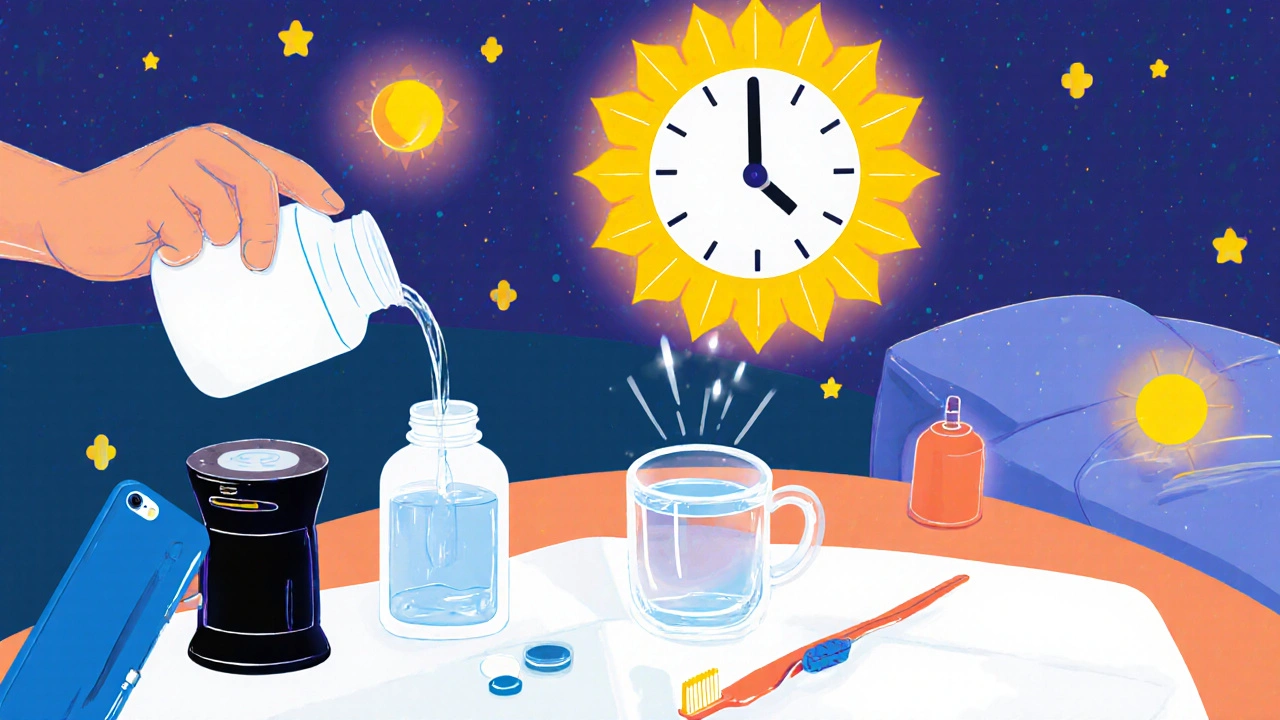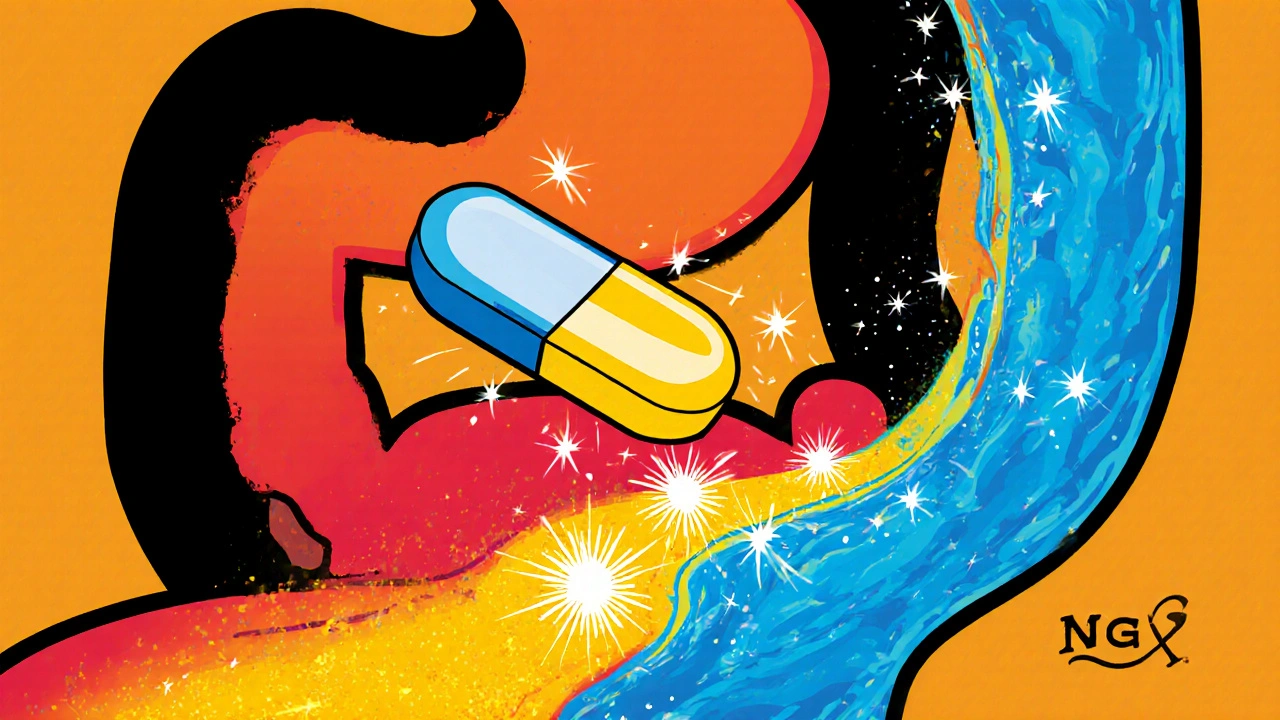26 Oct 2025
- 12 Comments
Thyroid Medication Timing Calculator
Calculate Your Best Dosing Time
Enter your meal times and supplement details to see your optimal dosing schedule.
Ever wonder why a tiny pill can feel like a heavyweight when you don’t take it just right? Levothyroxine is a synthetic form of the thyroid hormone T4 that millions of people rely on every day. Its job is simple-replace missing hormone and keep the body’s metabolism humming. But the drug’s effectiveness hinges on one fragile factor: levothyroxine absorption. Miss the timing or mix it with the wrong food, and your thyroid‑stimulating hormone (TSH) can swing out of range, bringing fatigue, weight gain, and a host of other symptoms back into play.
How Levothyroxine Gets Into Your Bloodstream
When you swallow a tablet, it lands in the stomach and quickly moves into the upper small intestine, the primary site of uptake. The gut needs a slightly acidic environment (pH ≈ 6) and an empty stomach for the tablet to dissolve fully. Once dissolved, the hormone crosses the intestinal lining and enters the portal vein, traveling straight to the liver and then the rest of the body. Because levothyroxine has a narrow therapeutic index, even a 10% dip in absorption can shift TSH by a full point or more.
Foods and Supplements That Block Absorption
Research consistently flags a handful of everyday items as absorption antagonists. Below is a quick rundown, each with a brief explanation of what goes wrong.
- Calcium supplement: Calcium binds to levothyroxine molecules, forming an insoluble complex that the gut can’t absorb. Studies show a 27‑36% reduction when taken within an hour of the pill.
- Iron supplement: Iron chelates the hormone in a similar way, cutting absorption by roughly 39%.
- Coffee: The caffeine and chlorogenic acids compete for the same transporters, leading to a 36% drop in uptake.
- Proton pump inhibitor (e.g., omeprazole, lansoprazole): By raising stomach pH, PPIs prevent the tablet from dissolving properly, shaving off up to a third of the dose.
- Soy product: Isoflavones interfere with the thyroid’s transport proteins, modestly lowering serum T4.
- Multivitamin with minerals: The combined calcium, iron, and zinc content creates a cocktail that can collectively knock absorption down 30% or more.
The common thread? All these items are best kept at least three to four hours away from your levothyroxine dose.
Morning vs. Evening: What Does the Science Say?
Guidelines have traditionally pushed a “take it on an empty stomach before breakfast” rule. Yet several trials paint a more nuanced picture.
| Timing Strategy | Mean TSH (mIU/L) | Absorption Impact |
|---|---|---|
| Fasting morning (30‑60 min before breakfast) | 1.06 ± 1.23 | Reference (100%) |
| With breakfast | 2.93 ± 3.29 | ≈ ‑70% |
| Bedtime (≥3 h after dinner) | 2.19 ± 2.66 | ≈ ‑55% |
| Evening before dinner (30 min after meal) | 2.31 ± 2.45 | ≈ ‑65% |
Early work (Bach‑Huynh et al., 2009) showed a stark rise in TSH when the pill was taken with breakfast. Later studies, like the 2020 systematic review by Virgilio et al., found that evening dosing actually produced lower TSH on average. A 2017 Indian study reported no statistical difference between morning and evening groups, suggesting individual variability.
Bottom line? Most patients achieve the most stable TSH when they can keep the stomach empty for 30‑60 minutes. If that’s impossible-say you’re a night‑owl or have erratic mornings-switching to a consistent evening schedule can work, but you’ll need close monitoring for the first two months.
Step‑by‑Step Routine to Maximize Absorption
- Place your levothyroxine bottle next to something you use every morning-your toothbrush, phone charger, or coffee maker (but don’t drink the coffee yet).
- Take the tablet with a full glass of plain water. Avoid juice, milk, or flavored drinks.
- Set a timer for 30 minutes. If you’re eating breakfast, wait until the timer goes off before you start.
- If you need calcium or iron, schedule those supplements at least four hours later (often after lunch or dinner).
- Keep a medication log in a phone app. Mark the time you took the pill and any missed doses.
- Check your TSH 6‑8 weeks after any timing change. Adjust only after seeing the lab results.
Simple habits like turning the bottle upside down after each dose can also help you remember whether you’ve taken it.
Special Populations: Tailoring the Timing
Pregnant women need the most reliable absorption because thyroid hormone supports fetal brain development. The ATA recommends the strict 30‑60 minute pre‑breakfast window and aims for a first‑trimester TSH below 2.5 mIU/L.
Patients on thyroid‑suppressive therapy after thyroid cancer often target TSH < 0.1 mIU/L. For them, even minor fluctuations matter, so a consistent routine (morning or evening) plus weekly TSH checks are advised.
Elderly patients frequently take calcium for bone health and multiple other meds. The Endocrine Society suggests spacing levothyroxine at least three hours from calcium, iron, and PPIs to avoid the steep absorption hit.

New Formulations That Bypass Timing Issues
In 2017 the FDA cleared Tirosint‑SOL, an oral solution that dissolves in the mouth. Clinical trials showed no significant TSH difference whether patients took it with or without food. Ongoing phase‑3 trials (NCT04567821) are testing a delayed‑release tablet that releases levothyroxine several hours after ingestion, aiming to make timing irrelevant. If those succeed, the current strict schedules could become a thing of the past.
Quick Checklist for Patients
- Take levothyroxine on an empty stomach (30‑60 min before food).
- Use only plain water-no coffee, juice, or milk.
- Separate calcium, iron, multivitamins, soy, and PPIs by 3‑4 hours.
- Choose a consistent time (morning or evening) that fits your lifestyle.
- Log each dose and any missed doses.
- Schedule TSH lab work 6‑8 weeks after any timing change.
- Discuss new formulations with your doctor if timing remains a barrier.
Frequently Asked Questions
Can I take levothyroxine with coffee?
No. Coffee can cut absorption by about a third. If you need caffeine, have it at least one hour after the pill.
Is evening dosing as effective as morning dosing?
It can be, but only if you stick to the same routine every night and monitor TSH closely for the first two months.
What should I do if I forget a dose?
If it’s less than 12 hours away from your next scheduled dose, just skip the missed one and take the next dose at the usual time. Don’t double up.
Do multivitamins affect my thyroid medication?
Yes, especially those that contain calcium or iron. Space them at least three to four hours apart.
Is the oral solution better for people with busy mornings?
For many, Tirosint‑SOL eliminates the food‑interaction issue, so you can take it with breakfast. Talk to your doctor about switching.
Whether you’re a new patient just starting levothyroxine or a veteran juggling multiple meds, the key is consistency. Small timing tweaks can keep your TSH in range, your energy up, and your doctor happy.


Rachel Zack
October 26, 2025If you cant be bothered to follow the simple timing rules, dont be surprised when your doctor yells at you.
Lori Brown
October 27, 2025Hey, I get that schedules can be a pain, but sticking to that 30‑minute empty‑stomach window really pays off! 😊
Even if you’re a night‑owl, just pick the same time each day and you’ll see steadier TSH results.
Trust the science – the data in the post backs it up, so give yourself credit for the effort.
Jacqui Bryant
October 28, 2025Just set an alarm with your phone and take the pill with water before you brew coffee. It’s simple and it works.
Paul Luxford
October 29, 2025Consistency is key; whether you choose morning or evening, make sure the stomach is empty for at least thirty minutes. This minimizes the variability seen in TSH levels.
Nic Floyd
October 31, 2025Levothyroxine absorption is contingent upon gastric pH, intestinal transit time and competitive binding with divalent cations🍽️ the drug’s bioavailability can diminish up to 35% with calcium or iron supplements the pharmacokinetic profile favors fasting administration – ideally 60 min pre‑prandial – to achieve optimal serum T4 concentrations
Johnae Council
November 1, 2025Look, the whole “no coffee” rule is just another way pharma keeps us in line while they cash in on separate meds. You’re basically forced to buy extra supplements to space everything out. It’s a circus, and the doctors love the chaos.
Manoj Kumar
November 2, 2025Ah, the humble thyroid pill, the unsung hero of modern metabolism, yet we treat it like a ticking time‑bomb that must be synchronized with the cosmos. If you think timing is a trivial detail, perhaps you’ve never tried calculating your own TSH fluctuations while juggling caffeine and calcium. In the grand theatre of endocrine regulation, the script is simple: empty stomach, wait, then swallow. Anything else is just improvisation, dear readers.
Hershel Lilly
November 3, 2025Good point about pH and binding, Nic. For patients on PPIs the timing shift can be critical, so a morning dose of levothyroxine before the acid‑suppressor often mitigates the interaction.
Carla Smalls
November 4, 2025Remember to log each dose in a tracking app; seeing the pattern helps you stay accountable and spot any missed days quickly.
Monika Pardon
November 5, 2025One might wonder why the medical establishment insists on such rigid protocols, especially when the same agencies that approved the pills also fund the studies that shape these guidelines. Could it be that the hidden agenda is to keep patients dependent on a regimented schedule, ensuring a steady market for supplemental calcium and iron products? The correlation between pharmaceutical recommendations and commercial interests is, to put it mildly, suspicious. Nonetheless, adhering to the suggested timing does appear to stabilise TSH levels, as evidenced by the data presented.
Rhea Lesandra
November 7, 2025Hey team, let’s dive into the nitty‑gritty of thyroid medication timing and come out stronger together.
First off, remember that your body is a finely tuned instrument, and levothyroxine is the sheet music that tells it how to play.
When you take the pill on an empty stomach, you’re giving the hormone the stage it deserves, free from the noisy distractions of food.
Skipping that window is like trying to read a novel in a crowded coffee shop – the message gets lost.
Research shows a clear pattern: fasting morning doses typically produce the most stable TSH numbers.
If mornings are chaotic for you, the evening route can be just as effective, provided you keep it consistent.
Consistency, not the exact hour, is what matters most for long‑term hormone balance.
Think of your medication schedule as a habit loop: cue, routine, reward – place the bottle next to your toothbrush and you’ll never miss a beat.
Use a full glass of plain water; avoid juice or milk because those liquids can bind to the hormone and pull it down.
Space out calcium, iron, and multivitamins by at least three to four hours – a simple calendar reminder can save you a lot of frustration.
For those on PPIs, consider taking the thyroid pill before the acid‑suppressor or discuss alternative therapies with your doctor.
Pregnant patients should be extra vigilant, aiming for that 30‑minute pre‑breakfast window to protect the developing baby.
If you’re dealing with thyroid‑suppressive therapy after cancer, even tiny fluctuations matter, so schedule regular TSH checks.
Tracking apps aren't just tech gimmicks; they provide a visual timeline that can reveal patterns you might otherwise miss.
And don’t forget to celebrate small wins – a stable TSH reading is a victory worth sharing with your support circle.
Lastly, stay curious, stay kind to yourself, and remember that a little planning today can prevent a lot of fatigue tomorrow.
Kasey Marshall
November 8, 2025Totally agree keep it simple and track it you’ll see better results